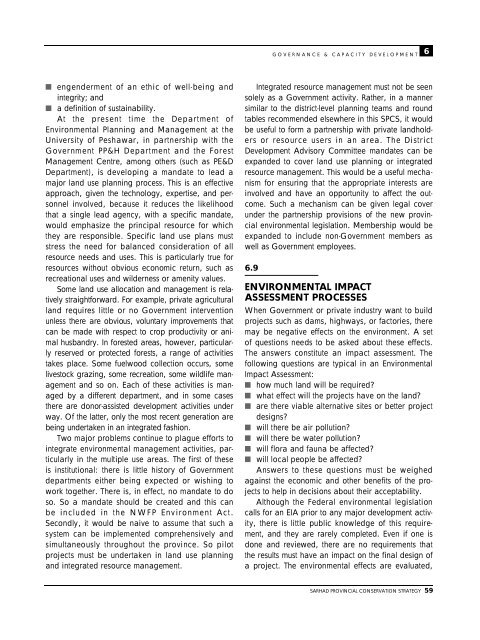Sarhad Provincial Conservation Strategy - IUCN
Sarhad Provincial Conservation Strategy - IUCN
Sarhad Provincial Conservation Strategy - IUCN
You also want an ePaper? Increase the reach of your titles
YUMPU automatically turns print PDFs into web optimized ePapers that Google loves.
■ engenderment of an ethic of well-being and<br />
integrity; and<br />
■ a definition of sustainability.<br />
At the present time the Department of<br />
Environmental Planning and Management at the<br />
University of Peshawar, in partnership with the<br />
Government PP&H Department and the Forest<br />
Management Centre, among others (such as PE&D<br />
Department), is developing a mandate to lead a<br />
major land use planning process. This is an effective<br />
approach, given the technology, expertise, and personnel<br />
involved, because it reduces the likelihood<br />
that a single lead agency, with a specific mandate,<br />
would emphasize the principal resource for which<br />
they are responsible. Specific land use plans must<br />
stress the need for balanced consideration of all<br />
resource needs and uses. This is particularly true for<br />
resources without obvious economic return, such as<br />
recreational uses and wilderness or amenity values.<br />
Some land use allocation and management is relatively<br />
straightforward. For example, private agricultural<br />
land requires little or no Government intervention<br />
unless there are obvious, voluntary improvements that<br />
can be made with respect to crop productivity or animal<br />
husbandry. In forested areas, however, particularly<br />
reserved or protected forests, a range of activities<br />
takes place. Some fuelwood collection occurs, some<br />
livestock grazing, some recreation, some wildlife management<br />
and so on. Each of these activities is managed<br />
by a different department, and in some cases<br />
there are donor-assisted development activities under<br />
way. Of the latter, only the most recent generation are<br />
being undertaken in an integrated fashion.<br />
Two major problems continue to plague efforts to<br />
integrate environmental management activities, particularly<br />
in the multiple use areas. The first of these<br />
is institutional: there is little history of Government<br />
departments either being expected or wishing to<br />
work together. There is, in effect, no mandate to do<br />
so. So a mandate should be created and this can<br />
be included in the NWFP Environment Act.<br />
Secondly, it would be naive to assume that such a<br />
system can be implemented comprehensively and<br />
simultaneously throughout the province. So pilot<br />
projects must be undertaken in land use planning<br />
and integrated resource management.<br />
Integrated resource management must not be seen<br />
solely as a Government activity. Rather, in a manner<br />
similar to the district-level planning teams and round<br />
tables recommended elsewhere in this SPCS, it would<br />
be useful to form a partnership with private landholders<br />
or resource users in an area. The District<br />
Development Advisory Committee mandates can be<br />
expanded to cover land use planning or integrated<br />
resource management. This would be a useful mechanism<br />
for ensuring that the appropriate interests are<br />
involved and have an opportunity to affect the outcome.<br />
Such a mechanism can be given legal cover<br />
under the partnership provisions of the new provincial<br />
environmental legislation. Membership would be<br />
expanded to include non-Government members as<br />
well as Government employees.<br />
6 . 9<br />
G O V E R N A N C E & C A P A C I T Y D E V E L O P M E N T 6<br />
E N V I R O N M E N TAL IMPA C T<br />
ASSESSMENT PROCESSES<br />
When Government or private industry want to build<br />
projects such as dams, highways, or factories, there<br />
may be negative effects on the environment. A set<br />
of questions needs to be asked about these effects.<br />
The answers constitute an impact assessment. The<br />
following questions are typical in an Environmental<br />
Impact Assessment:<br />
■ how much land will be required?<br />
■ what effect will the projects have on the land?<br />
■ are there viable alternative sites or better project<br />
d e s i g n s ?<br />
■ will there be air pollution?<br />
■ will there be water pollution?<br />
■ will flora and fauna be affected?<br />
■ will local people be affected?<br />
Answers to these questions must be weighed<br />
against the economic and other benefits of the projects<br />
to help in decisions about their acceptability.<br />
Although the Federal environmental legislation<br />
calls for an EIA prior to any major development activity,<br />
there is little public knowledge of this requirement,<br />
and they are rarely completed. Even if one is<br />
done and reviewed, there are no requirements that<br />
the results must have an impact on the final design of<br />
a project. The environmental effects are evaluated,<br />
SARHAD PROVINCIAL CONSERVATION STRATEGY 59

















